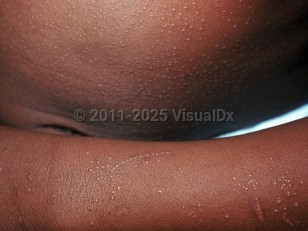Lichen nitidus in Adult
See also in: AnogenitalAlerts and Notices
Important News & Links
Synopsis

Lichen nitidus is a benign, chronic, cutaneous eruption characterized by the presence of small, discrete, uniform, often skin-colored papules that present in clusters or linear arrays. It most commonly affects children and young adults, although it can be found in patients of all ages.
Lichen nitidus may be generalized or focal, but it is commonly found on the chest, abdomen, flexor surfaces of the upper extremities, dorsal hands, and anogenital region (including the shaft and glans of the penis). Lichen nitidus actinicus is a variant of lichen nitidus that has been reported more frequently in Black individuals as well as individuals from the Middle East and Indian subcontinent. Patients may complain of pruritus over affected areas, although these micropapules are typically asymptomatic.
While the etiology of lichen nitidus remains unclear, it is important to note that it is typically not associated with laboratory abnormalities. Medication-related cases (following administration of nivolumab, tremelimumab, mogamulizumab, and interferon alpha) and familial forms have been reported.
Lichen nitidus is chronic and persistent, but the majority of patients ultimately clear spontaneously over the course of several months without residual atrophy or pigmentary changes.
Lichen nitidus may be generalized or focal, but it is commonly found on the chest, abdomen, flexor surfaces of the upper extremities, dorsal hands, and anogenital region (including the shaft and glans of the penis). Lichen nitidus actinicus is a variant of lichen nitidus that has been reported more frequently in Black individuals as well as individuals from the Middle East and Indian subcontinent. Patients may complain of pruritus over affected areas, although these micropapules are typically asymptomatic.
While the etiology of lichen nitidus remains unclear, it is important to note that it is typically not associated with laboratory abnormalities. Medication-related cases (following administration of nivolumab, tremelimumab, mogamulizumab, and interferon alpha) and familial forms have been reported.
Lichen nitidus is chronic and persistent, but the majority of patients ultimately clear spontaneously over the course of several months without residual atrophy or pigmentary changes.
Codes
ICD10CM:
L44.1 – Lichen nitidus
SNOMEDCT:
41890004 – Lichen nitidus
L44.1 – Lichen nitidus
SNOMEDCT:
41890004 – Lichen nitidus
Look For
Subscription Required
Diagnostic Pearls
Subscription Required
Differential Diagnosis & Pitfalls

To perform a comparison, select diagnoses from the classic differential
Subscription Required
Best Tests
Subscription Required
Management Pearls
Subscription Required
Therapy
Subscription Required
References
Subscription Required
Last Reviewed:12/10/2018
Last Updated:01/05/2022
Last Updated:01/05/2022
 Patient Information for Lichen nitidus in Adult
Patient Information for Lichen nitidus in Adult
Premium Feature
VisualDx Patient Handouts
Available in the Elite package
- Improve treatment compliance
- Reduce after-hours questions
- Increase patient engagement and satisfaction
- Written in clear, easy-to-understand language. No confusing jargon.
- Available in English and Spanish
- Print out or email directly to your patient
Upgrade Today

Lichen nitidus in Adult
See also in: Anogenital
